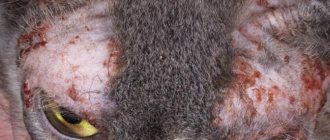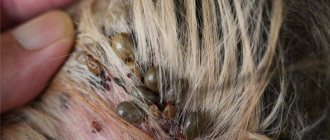Treating flea dermatitis at home
Flea dermatitis is difficult to cure at home.
At the first appearance of symptoms, you should consult a veterinarian. He will give the pet injections that contain a glucocorticosteroid component to relieve the symptoms of itching. After using this drug, treatment is carried out at home. How to treat:
- Once every two weeks you need to wash the animal with a special anti-parasitic shampoo. The most popular of them: Phytoelite, Bars.
- Treat your cat's skin with insecticidal cream. Wear special collars. Use flea drops.
- Wet cleaning of the premises using antiparasitic agents.
- Balanced diet.
- Immunomodulatory drugs.
Fighting allergies
For signs of allergies, you can use a strong tincture of chamomile. It will not only relieve itching, but also promote wound healing. You can also use an infusion of string and sage. To eliminate allergy symptoms, brew 1-2 tablespoons of herbs in 1 glass of water. The resulting product is used to treat the pet’s skin.
It is necessary to remove worms, which can also cause an allergic reaction. Antihistamines are used: tablets, suspensions. The following drugs relieve itching well: Septo-spray, Alamicin, Stop-Itching, Suprastin, Tavegil.
Intensive therapy
In its advanced form, flea dermatitis in a cat can cause serious harm to health. Festering wounds in cats can be treated with antibiotics in tablets or injections.
Remedies for flea dermatitis in cats:
- Capstar. It works within an hour after taking the drug. Releases a toxin that kills fleas when they bite an animal's skin. This special drug is used when fleas need to be removed as soon as possible.
- Essential. Eliminate itching and prevent the animal from becoming infected again.
- Stronghold. Helps rid the animal of parasites and eliminates itching within a day. Can be used for kittens from three months.
- Synthesis or Tsamaks. Relieves inflammation, heals wounds.
- Infusion of wormwood or tansy. Used for surface treatment after sterilization of the room and bedding.
If your cat does not improve and symptoms of flea dermatitis persist, you should contact your veterinarian.
Accompanying illnesses
Flea dermatitis in a cat provokes the development of infectious diseases of the skin, which can lead to the death of the pet. If treatment is not timely, the animal may develop an atonic form of the disease, which will torment the animal for the rest of its life. With it, it is only possible to temporarily alleviate the animal’s condition; it cannot be completely cured.
Treatment at home
For flea dermatitis, the pet is prescribed drug therapy. It provides:
- Insecticide treatment of dogs. For this purpose, specialized anti-flea shampoos, drops, and ointments are used. The animal must be treated with these products 2-3 times with an interval of 10-14 days. During this time, new larvae appear from insect eggs that did not die when the insecticide was first applied. Repeated treatment of your pet allows you to get rid of them quickly.
- Using antihistamines to relieve allergy symptoms. In some cases, they can be replaced with glucocorticosteroids. The drugs are used orally or in the form of external agents. The duration of treatment with such medications is usually 10-14 days. If they do not give the desired effect, the veterinarian will have to replace them with medications of similar action that have a different active substance.
- The use of antibacterial ointments. They are used in advanced cases of the disease to prevent secondary infection of damaged skin.
The average treatment period for a pet from flea dermatitis is 14-21 days. For the therapy to have the desired effect, the dog breeder must strictly follow all the veterinarian’s instructions, use an integrated approach to treatment, and follow the dosage of medications.
Remember that the treatment regimen for each specific pet is drawn up taking into account its breed, weight, general condition, and degree of infection. You cannot use prescriptions given by a doctor to another pet to combat dermatitis. This will not only not help cope with the disease, but will also harm your dog.
Note that the presented treatment allows you to stop an attack of flea dermatitis, but does not eliminate its cause - an allergy to flea saliva. Therefore, the animal owner should always remember the high risk of relapse of the disease and take the necessary preventive measures to avoid this.
Disease prevention
Flea dermatitis is easier to prevent than to cure. Disease prevention:
- Treat your cat for fleas and worms every six months.
- Limit your cat's time with other animals.
- Do not let the animal go outside.
- If your cat is outdoors, put a flea collar on her.
- Wash the soles of your shoes as soon as you get home.
- If you have been in contact with another animal, wash your hands afterward.
- Maintain a varied diet for your cat.
- Keep the pet's bedding and the room in which the cat is kept clean.
- Veterinarians recommend having your pet examined at a veterinary clinic once every six months.
- Sometimes wash your pet with special shampoos for cats.
- Brush your cat's fur with a brush several times a week.
Even if your pet does not go outside, does not come into contact with other animals and does not leave the house, this does not mean that the cat cannot pick up fleas. It is very easy to bring parasites along with some object or on your clothes.
Fleas do not live on animals, but only feed. Accumulations of fleas can be found in carpets, under furniture, and in dusty corners of the apartment.
Prevention measures
Prevention rules:
- Clean your pet's bedding regularly.
- Periodically bathe your pet using anti-flea shampoo.
- To prevent infection, use drops on the withers against fleas and helminths once every six months.
- If your pet often goes outside, put an anti-flea collar on it.
- Avoid exposing your indoor cat to outdoor animals.
- Regularly carry out wet cleaning using bleach.
- If there are cockroaches in the house, be sure to remove them.
- Keep shoes out of reach of your pet.
Anti-flea collar helps prevent fleas and ticks
If your animal suddenly develops itching, be sure to show it to a veterinarian. Using special optical equipment, the doctor will be able to determine the presence of even a small amount of parasites.
General symptoms of dermatitis in dogs
The first thing the owner needs to look at is the behavior of the pet. Why is it worth observing other than skin signs? As previously mentioned in the article, skin characteristics are purely individual. That is why allergic inflammation of the dermis can vary equally among different breeds.
If in an animal with delicate skin redness occurs immediately after a flea bite, then in an animal with rougher skin, an allergy to the enzymes contained in saliva may occur much later. Thus, the first priority is to observe the animal's behavior.
Pet owners need to know the main symptoms of flea dermatitis
This is important in order to start therapy in a timely manner. These include:
- painful itching, which leads to the need to constantly scratch the surface of the skin;
- baldness in areas where scratching occurs;
- anxiety in dogs and cats.
If there is serious damage to the body, then the animal may experience:
- vomit;
- lack of interest in food;
- indigestion.
Dermatitis in dogs can be of several types, however, no matter which of them is diagnosed at the moment, all have common symptoms that do not depend on the causes of development. These signs are:
- the animal experiences pain in the affected area of the dermis, itching;
- at the site of direct damage, the temperature of this part of the body rises;
- redness of the dermis in areas of scratching and injury;
- slight bleeding is possible, followed by the formation of thin, dried blood;
- the development of traumatic edema, followed by the inflammatory process and skin changes.
In the absence of timely treatment, the disease develops into a chronic form, when the subcutaneous tissue and the dermis itself swell, and the hair falls out.
The main symptoms that indicate flea dermatitis:
- severe itching that the animal feels;
- numerous wounds due to the dog scratching and biting the skin;
- hair falling out, bald patches appearing on the body;
- lack of appetite, stomach problems, vomiting;
- inappropriate behavior, irritability, frequent whining or barking.
An allergic reaction due to frequent flea bites can be immediate or delayed. An immediate reaction will be observed only in dogs with hypersensitive skin, but there are many fewer of them, and therefore the majority have a delayed reaction to numerous bites.
That is why dermatitis becomes noticeable already at the level of its intensive growth.
Dermatitis itself manifests itself as excessive dryness of the skin and the appearance of numerous crusts, papules, and seborrhea. Flea dermatitis can affect the entire body of the animal, but this does not affect the front of the dog's head, ears and feet.
Symptoms
As a rule, the main symptoms of flea dermatitis in dogs include severe, debilitating itching , due to which animals sometimes chew their paws until they bleed and bleed. Fortunately, it doesn’t always come to this, and most often the dog just itches. But he does it selflessly and frantically, indulging in this activity constantly. However, even antihistamines help only for a short time, since hungry fleas bite your pet all the time.
If the dog is free- or semi-free-range, the owners may not notice anything for a long time. For dogs that live in apartment conditions, this, as a rule, does not come to this, since the owner still takes some measures to eliminate the “flea kingdom.” Often the clinical picture appears sporadically, but over time, if nothing is done, the animal’s condition will inevitably worsen. Young puppies and dogs with a severe flea infestation may well die, and therefore it is better not to delay treatment.
Development of flea dermatitis in humans
There are several varieties of fleas, each of which has its own living conditions. As a rule, animal fleas are not dangerous to humans, but in some cases, in the absence of a suitable environment, a flea can temporarily settle on the human body.
Important! The danger of a flea bite to a person is not an allergic reaction or itching, but the possibility of blood poisoning.
Moreover, some dermatological (dermatophiliasis, pulicosis and other pathologies) and infectious diseases (anthrax) are transmitted through a flea bite. Most pets are susceptible to flea allergy dermatitis, but this does not mean the disease is safe. Advanced forms of pathology are characterized by the development of complications, therefore, when identifying the first symptoms of the disease, you should seek qualified help from a specialist. In addition, veterinarians, as well as people who breed cats and dogs, recommend the use of preventative agents, such as flea collars, tar soap, and insecticidal drops.
Causes of flea dermatitis in cats
Flea dermatitis is an allergic reaction of pets to the saliva secreted by fleas when bitten. Kittens under 1 year of age are most susceptible to flea dermatitis. The cause of flea dermatitis in adult cats is weak immunity.
Possible consequences of fleas
Fleas, when they bite through the top layer of an animal's skin, secrete saliva into the blood. Allergies can be caused by the saliva of parasites. Possible consequences of flea dermatitis:
- The animal is weakened and exhausted.
- Aggressive and restless reaction of the cat to stroking.
- Development of an infectious skin disease.
- Flea bites are accompanied by helminth infection.
Symptoms of the painful period
The onset of the disease is usually asymptomatic and, in most cases, the course is mild. But this does not mean that the disease should be underestimated. This is often overlooked when a doctor diagnoses it, and there is not enough knowledge about it.
After an asymptomatic period, a small spot, segment or redness mixed with purulent secretion may appear at the site of the scratch. The first signs usually appear after a few days of the pathogen appearing in the blood. Then there is an increased body temperature, fever and the lymph nodes enlarge, becoming visible under the skin. They are both painful and can be filled with pus.
The most enlarged is the adjacent lymph node, located in close proximity to the scratch and the penetration of the pathogen. Ultrasound examination can demonstrate an increase in the rest of them. Invisible enlargement of lymph nodes may last for 6 months. After this time, it is difficult to associate scratches with existing symptoms, making it difficult to diagnose the disease.
Related disorders that are also difficult to associate with simply pampering your pet are the following:
- Headache,
- Pain in the back or abdominal cavity,
- Vomit,
- Diarrhea,
- General malaise,
- Lack of appetite.
In people with a well-functioning immune system, the changes are usually local and are not as severe in consequences as flea dermatitis in cats. With insufficient immunity, they can become generalized and even, in extreme cases, end in death.
Diagnosing the disease is much easier if the clinical symptoms are combined with the fact of scratches and the presence of fleas.
Main manifestations of flea dermatitis in cats
The most common manifestations of flea dermatitis in cats are:
- miliary dermatitis - redness and multiple blisters (vesicles) appear on the skin, which, when opened, form small erosions. After the erosions dry out, numerous crusts appear. With a long course of the disease, the affected areas acquire a dark color - acanthosis nigricans develops. The fur thins and falls out. The disease is accompanied by unbearable skin itching; when scratching, infection occurs with secondary microbial flora;
- formation of foci of baldness in the absence of inflammatory manifestations;
- development of the eosinophilic granuloma complex - accumulations of eosinophils and lymphocytes in the lesions take part in the development of all its forms. Manifestations: eosinophilic granuloma - looks like: whitish nodules or tubercles on the oral mucosa;
- linear intradermal thickenings on the body.
- nausea;
- deterioration of the cat’s general condition;
- irritability;
Photo gallery: manifestations of flea dermatitis in cats
baldness is a characteristic sign of flea dermatitis
eosinophilic granulomas look like intradermal thickenings in the shape of a line; eosinophilic plaques can merge to form continuous eroded surfaces
acute dermatitis caused by an allergy to flea bites; miliary dermatitis is represented by small erosions and crusts on the skin
Treatment of flea dermatitis
There are a lot of drugs that save you from insect attacks.
Antihistamines
Antihistamines that contain calcium, sodium thiosulfate and hormones are used. Medicines containing calcium reduce the permeability of all blood vessels. At the same time, swelling is reduced and itching is eliminated. But such drugs have their drawbacks. They should only be administered intravenously, under the close supervision of a veterinarian.
Sodium thiosulfate, which is contained in medications prescribed by a veterinarian, is also administered intravenously and in a course. The substance inhibits the development of an allergic reaction, and with early treatment, you can completely rid the animal of allergies.
Conventional antihistamines work well against itching. Among the most popular and harmless to the animal:
- "Suprastin";
- "Diphenhydramine";
- "Tavegil";
- Zyrtec.
The drug "Suprastin"
The drugs are used for 3 to 5 days, after which the doctor decides to end or continue therapy.
Hormonal
Hormonal medications, for example, Prednisolone, are widely used. The use is carried out over a long period of time, starting with a large dose, gradually reducing it to nothing. The effect is noticeable, allergic symptoms are eliminated. The dosage is calculated depending on the body weight and age of the animal. But hormones also have side effects. They have a bad effect on the immune system, complicate the process of assimilation of food, and slow down metabolic processes in the body. Therefore, long-term use of this treatment is not recommended.
Important! In order for drug treatment to bring the desired effect, it is necessary to ensure not only the availability of all necessary medications, but also to create appropriate conditions for keeping the pet
Diet
Changes should also affect food. Properly selected nutrition will speed up the healing process and relieve inflammation of the skin.
If the animal eats dry food, you should pay attention to therapeutic diets:
- Royal Canin Skin;
- Econuba dermatosis;
- Hills - Z.
If your cat prefers home-cooked food, you need to add omega-3 acid during cooking, for example, Nordic naturals Omega brand.
Drops
- "Essential 6". Eliminate itching and prevent re-infection. Available in small dosage bottles.
- Stronghold. Designed for cats and kittens from 3 months. Eliminate itching and kill parasites within 24 hours.
Drops "Essential 6"
Powder
- "Zamaks". Wound healing agent. Apply to affected areas of the skin.
- "Synthesis". Improves the healing process. Relieves inflammation and redness.
The ideal combination of ingredients allows you to achieve excellent results. Use the following recipe: talc - 70 g, patchouli oil - 20 drops, lemon oil - 50 drops, tea tree oil - 50 drops. Mix all ingredients thoroughly.
Collar
- "Leopard". Provide protection for the animal for up to 7 months. The smell repels parasites, as a result of which insects do not bite the cat.
- Baffo. The collar is saturated with a large amount of insecticidal substance. But such collars can only be used after the kitten reaches three months of age.
Shampoo
- MR.Kiss. Swiss manufacturer of animal cleaning products. Eliminates insects while moisturizing the skin.
- Rolf Club. The most effective remedy, however, the composition is less delicate, so use begins at three months.
Spray
- Front-line. The volume of this drug allows its use for up to 20 months. At the same time, a single treatment will protect the animal from insects for 40 days.
- Hartz spray is divided into types depending on the age and breed of the animal. Large volume, efficient operation. The spray is hypoallergenic, which means it can also be used for kittens older than 1 month.
Spray Front-line
Treatment of flea dermatitis
Let us immediately note that the most important thing is to cure dermatitis of flea etiology in very young kittens and young animals. If the invasion is severe, they may simply die! Since not all medications are suitable for young animals, we would advise using wormwood oil: it effectively repels parasites without causing any harm to the cat’s body.
The only reliable treatment for flea dermatitis in cats is the physical destruction of parasites and disinfestation of the environment. Only in this case can you not only cure the animal, but also prevent relapses of such an unpleasant disease. Remember that 90% of all fleas only feed on cats (and on humans too), but live in the house itself. Therefore, if you do not wash and disinfect the apartment, you will only waste your energy and money buying medications to treat your animal.
And further. If you have several animals at home, including dogs, rabbits and other similar animals, you will have to treat all of them for fleas, since otherwise you will again waste your medications. You can read about the destruction of fleas here, but for now we will focus on describing the treatment of dermatitis itself.
It is very important to immediately treat secondary skin infections caused by the contamination of wounds and scratches with pathogenic microflora. In severe cases, broad-spectrum antibiotics are prescribed, but in most situations it is possible to get by with antibacterial ointments and regular washing of the animal (use only shampoo prescribed by a veterinarian)
Antihistamines and corticosteroids are prescribed for flea dermatitis to relieve persistent itching and make life more pleasant for the animal. Please note that steroids are also great for relieving inflammation, but you definitely shouldn’t overdo them, as they sometimes have very serious side effects. Therefore, these products should only be used under the supervision of an experienced veterinarian.
In this case, special preparations are used, peculiar synthetic analogues of substances contained in flea saliva. They are administered in fractional portions over several weeks, after which the animal’s body ceases to react so sharply to the bites of these parasites. So far this technique is not very popular and is in the testing stage. When treating, you should follow a few simple rules:
If you use insecticidal drops, it is not advisable to wash the animal, as the effectiveness of the drug will be reduced to a minimum.
Never, under any circumstances, mix medications, as under such conditions they can turn into poison, and treatment at home will kill your pet.
Do not use drops or other flea treatments intended for dogs on cats. The doses and active ingredients are different there.
And further. Unfortunately, flea allergic dermatitis is not the only “joy” that appears after a severe flea infestation. These cute insects are often distributors of dangerous helminthiases, and therefore it doesn’t hurt to give your cat antihelminthic drugs in prophylactic doses.
How does flea dermatitis occur?
Flea dermatitis is an inflammation of the skin at the site of flea bites, caused by an allergic reaction to the saliva of the parasites.
There are three types of flea dermatitis:
- Spicy. This form of dermatitis has pronounced symptoms. It occurs rapidly, develops quickly, and is accompanied by severe itching.
- Chronic. This form of dermatitis is characterized by constant relapses and develops in the absence of treatment for the acute stage of the disease. It can no longer be treated. In the chronic form of flea dermatitis, the presence of parasites is no longer necessary.
- Sluggish. This type of dermatitis combines the symptoms of the first two. It is characterized by an acute stage, improvement and secondary manifestation. Relapses occur frequently. This stage is difficult to treat, and the prognosis is usually unfavorable in terms of the disease becoming chronic.
Flea saliva contains allergens. At the site of the parasite bite, the skin becomes irritated and itching appears, which greatly worries the animal. The cat scratches the bite site. The wounds easily become infected, become inflamed, and become wet. The hair on the affected area falls out, breaks off, and bald patches appear.
Flea dermatitis in cats can become severe
Since flea dermatitis is caused by allergens contained in the saliva of parasites, cats are most susceptible to this disease:
- prone to allergies;
- kittens (since their immunity is not yet fully formed);
- weakened animals;
- representatives of some breeds (especially hairless ones).
Light-colored cats are also at risk.
Don’t think that only a cat walking outside can pick up fleas. An unpleasant surprise may be the presence of these parasites in those pets who never leave the apartment. The thing is that the owner can bring fleas in the folds of clothing or on shoes. Fleas can also be found in the entrance hall if a cat accidentally jumps out onto the stairwell. If there is a dog in the house, then it may be the culprit for the appearance of fleas in the house.
The owner can bring fleas into the house on his shoes.
Types of dermatitis
Feline dermatitis is a skin disease that is usually a symptomatic manifestation of other ailments.
Based on their manifestation, the following types are distinguished.
Wet or weeping
With this skin lesion in an animal, the affected areas of the skin become wet, liquid (ichor or pus) oozes from them, and the hair falls out.
Weeping dermatitis in cats
Purulent
This type is characterized by the formation of small or extensive ulcers and scratches on the skin, into which infection penetrates. As a result, pus flows from the inflamed areas. Due to the fact that during inflammation the sensitivity of the skin increases, microorganisms very quickly penetrate into the tissue and multiply. As a result, the infection spreads like lightning throughout the entire skin.
Secondary infection due to the development of pathogenic bacteria on the affected skin
Surface
The mildest form, in which the skin turns red and may develop a small rash.
Superficial dermatitis in the form of a rash
Based on their occurrence, they are divided into two groups:
- Simple - is the result of exposure to the skin by a collar, rough and sharp grass, hard clothing, etc. This species is more common in hairless animals, since their skin is not protected by thick hair.
- Allergic – this includes all other types (flea, tick, bacterial, atopic, miliary, etc.).
What is flea dermatitis?
Dermatitis is manifested by inflammation of the skin resulting from exposure to an irritant, that is, they are considered allergic diseases. For flea dermatitis to occur, it is not at all necessary that the pet be covered in fleas, since a couple of bites from random insects are often enough for its development. Young cats between nine months and three years of age, as well as those with short hair or hairless breeds, are considered to be most sensitive to such a reaction.
Up to two dozen different allergens can be simultaneously present in a flea's saliva, one of which is likely to lead to an allergic reaction.
The disease develops as follows:
- flea saliva containing the allergen after a bite gets on the skin or under the skin of the cat;
- the allergen penetrates the layers of the epidermis;
- subsequently it penetrates into the lymph;
- Together with the lymph, the allergen spreads throughout the animal’s body;
- in response, cells of the immune system initiate a protective reaction.
It has been noticed that manifestations of dermatitis occur not only at the internal level; quite quickly they also manifest themselves in the form of external rashes, which quickly progress and, if urgent measures are not taken, cause significant discomfort to the cat and even change its behavior.
Diagnosis of flea dermatitis
After a home examination, the cat should be taken to a veterinarian.
There is a way to determine the presence of flea dermatitis at home. To do this you will need to do the following:
- Comb the animal.
- Moisten his fur a little with water.
- Lay a sheet of white paper and ruffle your pet over it.
Then you should carefully examine the marks left on the sheet. If rusty-brown spots appear, this indicates that there is flea feces on the animal’s skin. However, you should not trust this test 100%; it is better to show the cat to a veterinarian.
When examining an animal, specialists first need to exclude the following diseases, which may manifest similar symptoms:
- pediculosis;
- invasion;
- dermatophytosis;
- drug allergies;
- sarcoptic mange;
- pemphigus foliaceus;
- psychogenic alopecia;
- cheyletiellosis;
- staphylococcal pyoderma.
When the possibility of infection with the listed ailments is excluded, samples are taken from the animal for allergens, after which the specialist will prescribe appropriate therapy and select the necessary medications for treatment.
Flea dermatitis in dogs: symptoms
- Flea dermatitis is also dangerous because it very easy to confuse with other skin diseases
- The dog's skin begins to constantly peel off, more and more new lesions appear on it, most of them on the stomach or other areas with delicate skin.
- A dog can tear its skin literally to the flesh, this disease causes it so much discomfort.
- Flea dermatitis in dogs can also manifest itself as a consequence of improper pet hygiene.
- The coat becomes very thin.
- Presence of fleas. The flea is very visible on light-colored fur.
- Sudden infections that the pet has never had before.
, for example, dandruff:
All of these symptoms may indicate the presence of flea dermatitis. However, for a more accurate diagnosis, you should consult a veterinarian
, who will prescribe all the necessary tests.
How is flea dermatitis in dogs diagnosed?
Diagnosis and final diagnosis, flea dermatitis, usually occurs based on the owner’s story and tests, as well as an in-person examination of the animal. Veterinary doctors will quickly help cure any disease, including dermatitis. How is the disease diagnosed? Of particular value are the bald spots that fleas leave behind. However, they do not always happen. In this case, flea feces are of greatest help. If you want to try to diagnose the disease yourself
, then you can put the animal on white paper and comb its fur.
All waste products of fleas should be placed in a glass of water and watch the reaction: if it is flea excrement, they will disperse in the water, like, for example, sugar or potassium permanganate. However, even if the feces completely dissolve, you should not 100% self-medicate your dog.
. It is better to seek help from a veterinarian, who will most likely take a skin scraping and perform the necessary manipulations with it to make an accurate diagnosis.
How to treat flea dermatitis at home
Having noticed a problem, you should not undertake treatment on your own, since hair loss and constant itching are symptoms that are characteristic of many other dermatological diseases, including lichen and problems caused by microscopic mites.
The type of therapy is selected by the veterinarian after a diagnostic examination has been completed.
Fighting allergies
In order to get rid of allergies, in almost every case the animal is prescribed injections with antiallergic drugs. As a rule, they contain glucocorticosteroids. After treatment, the unpleasant symptoms recede.
After stopping allergic manifestations, you need to get rid of the main provocateur - the fleas themselves. To this end, the pet owner must perform the following steps:
- Fight against parasites on the cat’s body. It is carefully, slowly, treated with insecticidal preparations. These products can have different shapes and application features. But the important point is the systematic processing. Approximately 3 weeks after the first treatment, undead fleas, which were still at the egg stage before treatment, may become active. Therefore, re-treatment after 21-22 days is mandatory. For better results, the doctor may additionally recommend using special shampoos for bathing the animal. They may contain active antibacterial and antifungal components.
- Spring-cleaning. Since fleas are capable of occupying any, even the most inaccessible, corners of the room (the inner surface of cabinets, chests of drawers, sofas, under the baseboard, in the joints of walls, etc.), owners need to thoroughly vacuum everything, wash all clothes and cat litter, and clean the closet and thoroughly clean the floor using disinfectants.
- Treatment of wounds. It is worth examining the animal for the presence of wounds and abscesses. Damaged areas should be treated with antiseptic agents. It is recommended to perform such manipulations until the wounds are completely healed (covering and scabs fall off).
Features of intensive care
In the case of an advanced form of flea dermatitis, intensive therapy is prescribed, carried out every 4-5 days.
It is important not to exceed the dosage of the drug, especially if a kitten under 1.5 years of age is being treated
Veterinarians suggest using drugs for intensive therapy that immediately destroy both exo- and endoparasites. Thus, it will be possible to simultaneously destroy not only worms, but also fleas. If it is not possible to buy such drugs, you can use drugs against two types of parasites. The interval between use should be at least 24 hours.
Flea drops should be applied to the animal's skin (not its fur). The optimal place for application is the withers area (between the shoulder blades). Don't forget about cats' habit of licking. Therefore, when applying flea products to the skin, you need to make sure that the animal does not lick itself.
Treatment for helminths
Since fleas, as mentioned earlier, are also capable of infecting cats with helminths, it is advisable to simultaneously combat these “unwanted guests.” Therapy is carried out using anthelmintic drugs. If used in tablet form, you can add medications to your pet's food. However, some animals sense foreign odors well and refuse to take such tablets.
Experienced owners advise giving the drug to the cat forcibly. However, it is not possible to force an animal to swallow a useful medicine in every case. Alternatively, you can try dissolving it in water and pouring the desired suspension into the animal’s mouth using a syringe. With such manipulation, it is worth injecting the drug as far as possible.
Do not forget that worms can be transmitted to the owner himself. Therefore, having discovered flea dermatitis and helminthiasis in your four-legged friend, each member of the family, especially children, should be tested for the presence of worms.
What you shouldn't forget about fleas
The opinion that only stray yard cats can become infected with parasites is stereotypical and untrue. In fact, they can parasitize long-haired Persian handsomes and short-haired British folds, as well as cats of any other breeds. Given the constant risk of infection, pet owners should definitely know a few basic facts about fleas:
- These insects feed on the blood of animals (sometimes they can bite humans).
- They do not live on the cat's body, but perceive it as a source of food. Fleas live in different parts of the living room, for example, under the bed, in old drawers, closets, etc.
- During their life, fleas go through several phases of their development. The first, as veterinarians and biologists point out, is the egg phase, and the last is the adult phase, which itself is capable of laying eggs and parasitizing on the animal’s body.
Treatment of dermatitis
Drug treatment of flea dermatitis in domestic cats is carried out according to a standard regimen, which involves the use of the following medications:
- drugs with anti-inflammatory effects;
- medicines with antibiotic properties;
- antiphlogistic nonsteroidal drugs.
When treating, you need to focus not only on the choice of medications that can cope with the flea form of dermatitis
It is equally important to create the necessary living conditions for the animal.
Antihistamines
To treat cats with symptoms of flea dermatitis, medications containing calcium sodium thiosulfate and hormones are used. With the help of calcium in the drug, it is possible to reduce vascular permeability, eliminate swelling and reduce itching. However, their disadvantage can be considered some features of application, when their administration involves only intravenous injections, which can only be done by a specialist.
The use of sodium thiosulfate is also carried out only intravenously and strictly in accordance with the prescribed course. Thanks to it, the allergic reaction is stopped, which relieves the cat of disturbing symptoms. Moreover, if you seek help early and start treatment in a timely manner with such a drug, you can completely get rid of allergies.
However, antihistamines occupy a special place in methods of therapy aimed against flea dermatitis. With their help, you can quickly cope with itching, and intended for animals, they do not have a harmful effect on their body. These medications are usually given to your cat for three to five days, after which only your veterinarian can decide whether to continue treatment or stop it. The most effective antihistamine medications for cats are prescribed Suprastin, Tavegil, Diphenhydramine or Zyrtec. Chlorpheniramine, which is taken orally twice a day, 2 ml, copes well with this task.
In some cases, antihistamines are not effective enough against allergies, then it is recommended to treat flea dermatitis using glucocorticosteroids.
Hormonal
Hormonal medications are very often prescribed for severe forms of allergies in animals. Typically, Prednisolone is used for these purposes, starting the course of treatment with a high dose and gradually reducing it. The dosage depends on the weight of the cat and its age, due to which the expected result with the elimination of the symptoms of an allergic reaction occurs in a short time. When carrying out treatment with hormonal drugs, it is necessary to take into account their downside, that is, their adverse effect on the vital processes of the animal’s body. Thus, their use may reduce immunity, disrupt metabolic processes, and complicate the processes of digestion and assimilation of food. It is for this reason that hormonal drugs should be used only if indicated for this type of treatment and not used for a long time.
Often a sick animal is offered local hormonal agents as a cream or ointment. Such a prescription is justified in case of contraindications to the use of systemic drugs.
Flea dermatitis in dogs: treatment
Therapy for this disease should be started only after you are completely sure that it really is dermatitis.
.
It should be remembered that it is impossible to completely overcome this condition. Maintenance therapy should completely relieve unpleasant symptoms, as this causes serious discomfort. With the pressing question “How to treat?” You should consult a veterinarian
, since only he can help solve such a delicate problem as flea dermatitis. Nevertheless, the most important part of the therapy was and remains the complete disinfection of the apartment where the dog lives.
Among other things, you should take into account that if there are other animals in the apartment
, then everyone will have to be treated for fleas.
This step is very important because fleas can jump from place to place. The next step should be a competent selection of medications. This should only be prescribed by a veterinary specialist. However, we consider it our duty to talk about what medications can be prescribed. First of all, these are drugs of the antiallergenic group .
Severe itching can be caused by allergies. For especially worried owners, we can say that dermatitis is completely safe for humans. And through scratching, an infection will enter the body faster. If scratches and wounds are found during the initial examination, the doctor will prescribe medications that will help speed up healing . The most common ointment is perhaps Vishnevsky's balm. It promotes faster healing of scratches and scratches, preventing them from spreading further. A mandatory point of successful therapy is careful hygiene of the animal - no walks if there is dirt on the street, as it can get into the wounds and cause even more harm.
Treatment also involves creating the necessary diet.
. During therapy, the doctor will advise you to remove all allergenic foods, such as fish and milk, from your diet. You can feed chicken as the most non-allergenic product; turkey with its beneficial substances and incredibly dietary meat, which even the most picky dog will appreciate, will also be appropriate.
Do you need to see a doctor if you suspect flea dermatitis in your dog?
Flea dermatitis in dogs is a condition that, if not properly treated, can significantly spoil the aesthetic appearance of the pet.
and also affect its safety. Contacting a veterinarian is a must in order for recovery to occur as quickly as possible. After all, even the most experienced dog owner is not able to independently and accurately make a diagnosis. For this purpose, you will need the most modern equipment, which is only available in veterinary medicine. Diagnosing dermatitis is quite a costly and expensive matter, but the results obtained will help maintain your pet’s quality of life and relieve it from debilitating itching. Once all symptoms have resolved, the animal should be regularly monitored by a treating specialist.
Our veterinary office has a highly specialized dermatologist who, based on the test results, will help you prescribe the correct treatment tactics, as a result of which you will again get a healthy and cheerful pet that will happily wag its tail.
How can calling a veterinarian to your home help if your pet has flea dermatitis in dogs?
Many dog owners are inclined to believe that calling a doctor to their home in Moscow is an unnecessary luxury that they can completely do without. In some ways they are right. However, there are situations when it is not possible to visit the veterinary center in person.
- The service of calling a veterinarian to your home can be useful in cases where:
- you suspect that your pet has a contagious disease that can spread to other animals sitting in line;
- the infection poses a danger to other people, but flea dermatitis is not at all contagious to humans;
- saving time, because our veterinarian gets to the client in a maximum of 40 minutes, while a classic trip to the doctor would take longer;
- saving nerve cells, which are known to not be restored;
- the opportunity to receive help from truly qualified doctors;
- After a visit to our veterinarian, you can additionally call a more specialized specialist who will help you understand the problem in detail.
Once you use such a convenient service as a doctor at home, you will no longer want to waste time in long lines at the veterinary center. After all, home is a calm, familiar environment for your pet, and there is a loving owner nearby who will support and not abandon you.
What you can save by calling a doctor at home
In our difficult times, many owners strive to save on everything, but the savings are not always justified. Nevertheless, by turning to a veterinarian for help, you will receive a total saving of personal time, which you can spend with your beloved pet and give him the attention he so needs.
- In addition to the veterinarian, you can call other highly specialized specialists, who you will not find in a regular veterinary center during the day:
- ratologist;
- dermatologist;
- dentist;
- allergist;
- immunologist;
- gynecologist;
- otolaryngologist.
Not every clinic can boast such a variety of specialists! Call a doctor at home and quickly appreciate all the benefits of such a service!











